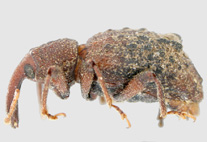Abstract
Frederick Octavius Pickard-Cambridge (1905) described the monotypic genus Hernandarioides based on the species Hernandarioides plana F.O. Pickard-Cambridge, 1905, from Bugaba, Panama. The etymology of the generic name was inspired by the pre-existing Hernandaria Sørensen, 1884, because of the obliteration of the scutal grooves (which in this case is a convergence between the two unrelated groups Ampycinae and Hernandariinae). The species description was based only on the female holotype. Modern taxonomic descriptions of laniatorean harvestmen are most commonly based upon male holotypes because females lack many diagnostic characters. The holotype, deposited in the Natural History Museum, London, is brittle and does not bring much meaningful information about the species. Hernandarioides was not originally included in any subfamily of Gonyleptidae, and was included by Roewer (1913: 464) in the Hernandariinae. Goodnight & Goodnight (1942: 18) described in Prostygninae the monotypic genus Kaluga along with the species Kaluga elongata Goodnight & Goodnight, 1942, from Casita Alta, a locality very close to Bugaba, providing uninformative illustrative material. A little later, Goodnight & Goodnight (1947: 15) synonymized Kaluga with Hernandarioides and Kaluga elongata with Hernandarioides plana. Kury (2003: 105) proposed the unjustified emendation Hernandarioides planus. Finally Kury & Alonso-Zarazaga (2011: 53) transferred the genus to the Ampycinae and explained that the grammatical gender of Hernandarioides is feminine, reestablishing the original inflection Hernandarioides plana.

